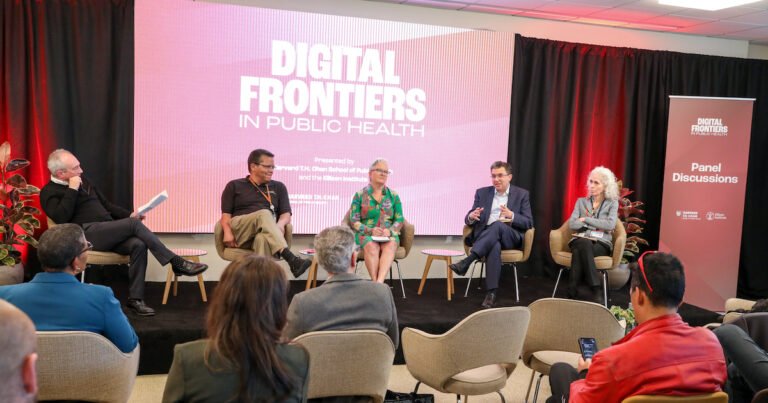
[ad_1]

Joshua Sharfstein, vice dean at Johns Hopkins Bloomberg and former Secretary of the Maryland Division of Well being from 2011 to 2014, stated that, at first of his time period in Maryland, half or two-thirds of the hospitals have been linked for information sharing, and the info would typically solely present data for scientific lookups, resembling whether or not the affected person underwent a CT scan at one other hospital.
“The leaders of that system got here and stated, ‘We envision this as a scientific program, however we do not see the place the cash can come from to construct it out for the entire state,'” Sharfstein acknowledged throughout Tuesday’s occasion on the Ellison Institute.
Sharfstein and his companions gave the leaders an ultimatum – he and his crew would get hospital techniques on board with the governor’s assist, funding could be offered via Medicaid or different methods, and a provision could be signed into regulation that designates the leaders because the state’s well being data change.
In flip, the leaders must double the scale of their board and add members of the general public to it, add a provision within the bylaws stating the well being secretary can wipe out the board if it is not performing in the very best curiosity of Maryland residents, and the service could be dubbed a public well being utility, not only a scientific program.
“It was actually a deal between us and the well being data change (HIE),” Sharfstein stated.
Streamlined information connectivity has been more difficult in Los Angeles County, particularly throughout the COVID-19 pandemic.
Barbara Ferrer, director of the Los Angeles County Division of Public Well being, stated there have been 4 fundamental wants for information to research what was occurring throughout the COVID-19 pandemic inside the county, which homes over 10 million individuals:
- Who’s getting sick, and the place are we having outbreaks, by sector and geography?
- How properly do the interventions work, together with vaccines and different measures?
- What variations have been our interventions making, together with through telehealth and cellular groups?
- What do staff and residents want and assume?
“I feel the place we do the worst is in that final space, nearly as if we do not care. However we do. However while you hear individuals speak about information, even all of us, we’ll speak about interoperability. We’ll speak concerning the datasets that we’ve got. However the information that we actually must change into trusted individuals in our communities is information about how individuals really feel, and what’s it that they assume they want, and the way can we be useful?” Ferrer acknowledged.
Anthony Iton, senior vice chairman of packages and partnerships on the California Endowment, says when he served as Alameda County’s well being officer, he was registrar of all births and deaths, which allowed him to take a extra targeted method to using information for neighborhood well being.
“Each loss of life certificates tells you what anyone died of; their race, ethnicity; the place they reside; and their age. So we might truly paint a narrative of loss of life in Alameda County about the way it occurred. We revealed maps on the census tract stage displaying how lengthy anyone might count on to reside,” Iton stated.
Nonetheless, Iton and his crew wished extra particular information, however hospital techniques refused to share it as a consequence of an absence of belief that public well being would shield the info.
“It was form of indicative of how little leverage public well being has,” Iton stated.
Claudia Williams, former CEO of Manifest MedEx and one-time senior advisor for well being expertise and innovation for President Obama’s Precision Drugs Initiative, says a crucial element to bettering well being outcomes is entry to personally identifiable and de-identified information that isn’t within the jurisdiction of public well being.
“We’re by no means going to have the ability to attain our greater targets of well being enchancment except there’s entry to information that permits us to have insights earlier than issues occur,” Williams stated.
All panelists agreed that change inside the health-data ecosystem throughout the states is critical for the good thing about public well being, however extra sources are wanted to make sure information interoperability turns into a actuality.
“This work can not occur with out sources, and it is going to should be sustained over a protracted time frame,” Ferrer stated. “We want long-term monetary funding on the federal, state and native stage. We have received to have the cash.”
Iton stated, “We do not have a nationwide healthcare system. We’ve got a federal healthcare system. So we’ve got a federation of fifty states. And that is baked into form of the relative distribution of energy, the flexibility to make choices. The nationwide authorities cannot make choices that the feds must comply with, and that is problematic. So, the management for this has to return on the state stage.”
Sharfstein argues for the necessity to prioritize public well being outcomes as it is not simply concerning the affected person encounter, however reasonably empowering individuals who can work with their communities. He confused the necessity to change the environments which are driving unhealthy well being.
“States must construct a knowledge infrastructure usable, not simply by public well being, but in addition by analysis by scientific people,” Williams stated. “It is a public good. We have to spend money on it as a public good. We have to align all of our coverage levers, and public well being wants to profit from that.”
[ad_2]